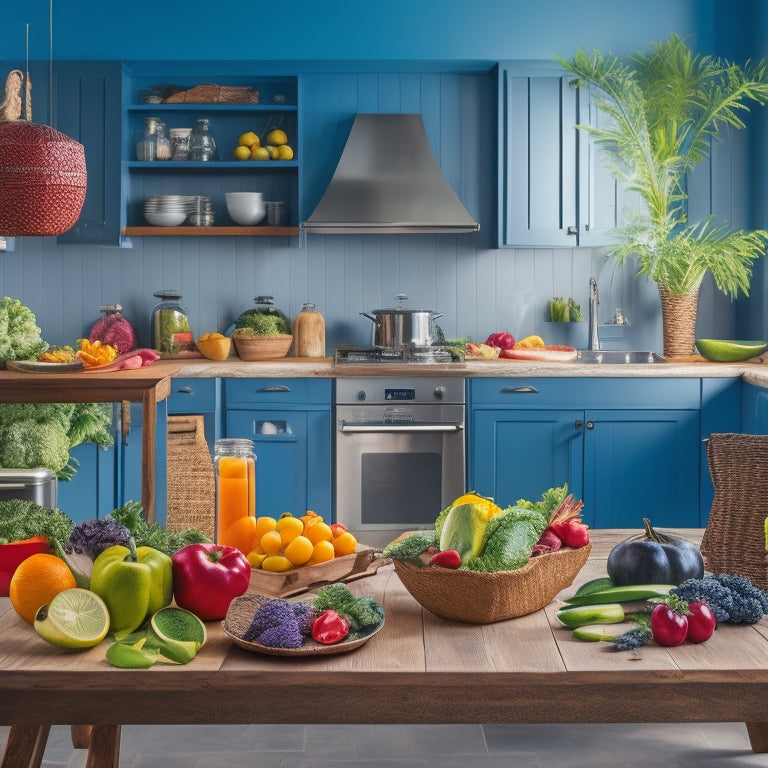
Create a Weight Loss Meal Plan That Works
Share
You're ready to create a weight loss meal plan that works for you. Start by determining your daily caloric needs based on your age, gender, weight, height, and activity level. Then, set realistic goals, like losing 1-2 pounds per week, and establish healthy habits like balanced eating, hydration, and sleep. Choose a meal plan template that suits your lifestyle and dietary needs, and consider downloadable kitchen meal plans for guidance. Prioritize meal planning, prep healthy meals in advance, and track your progress to stay motivated. By following these steps, you'll be on your way to a personalized weight loss plan that sets you up for long-term success - and there's more to come.
Key Takeaways
• Determine daily caloric requirements based on age, gender, weight, height, and activity level to create a personalized meal plan.
• Focus on portion control and balanced macronutrient intake of protein, carbohydrates, and fats to achieve calorie goals.
• Prioritize whole, unprocessed foods and limit unhealthy choices to promote sustainable weight loss.
• Incorporate exercise routines and stay hydrated to support weight loss goals and overall health.
• Regularly track progress, celebrate milestones, and refine meal plans to stay motivated and on track.
Understanding Your Dietary Needs
To craft an effective weight loss meal plan, you must determine your daily caloric requirements, which vary depending on factors like your age, gender, weight, height, and activity level.
Once you understand how many calories your body needs, you can concentrate on achieving a balanced macronutrient intake. This involves ensuring you're receiving the correct amounts of protein, carbohydrates, and fats to aid your weight loss objectives.
Portion control is also vital, as consuming the appropriate amounts of food will help you adhere to your calorie goal.
Moreover, it's crucial to take into account any food allergies or intolerances you might have, such as lactose intolerance or gluten sensitivity. By considering these aspects, you can develop a personalized meal plan that caters to your specific requirements and promotes sustainable weight loss.
Setting Realistic Weight Loss Goals
With your dietary needs understood, you're now ready to define achievable weight loss objectives that will guide your meal planning decisions. Setting realistic goals is essential for success, as it helps with managing expectations and staying motivated. Aim to lose 1-2 pounds per week for a sustainable weight loss.
| Goal | Actionable Steps |
|---|---|
| Healthy Habits | Establish a balanced diet, increase water intake, and get 7-8 hours of sleep |
| Balancing Macros | Allocate 15-20% of daily calories to protein, 25-30% to fat, and 55-60% to carbohydrates |
| Exercise Routine | Aim for 150 minutes of moderate-intensity exercise or 75 minutes of vigorous-intensity exercise per week |
Choosing the Right Meal Plan Template
You'll want a meal plan template that suits your lifestyle, dietary needs, and cooking habits, so it's vital to explore various options before committing to one. A template that's too rigid or complex can lead to frustration and abandonment. Look for templates that offer flexibility and customizing options to accommodate your unique needs. Consider templates with interchangeable meal slots, adjustable portion sizes, and space for notes or substitutions.
Staying consistent with your meal plan is key to achieving your weight loss goals. Choose a template that's easy to follow and review regularly. A template with a clean design and clear instructions will help you stay on track. Consider digital templates that can be accessed on your phone or computer, making it easy to plan and track your meals on-the-go.
Downloadable Kitchen Meal Plans
Having found a suitable meal plan template, it's time to explore downloadable kitchen meal plans that can help you put your plan into action. These plans provide a detailed guide to meal prep, ensuring you're cooking and portioning the right foods to support your weight loss goals.
By incorporating downloadable kitchen meal plans into your routine, you'll be able to achieve nutritional balance and make healthy eating a habit. These plans typically include a grocery list, recipes, and step-by-step instructions, making meal prep a breeze.
You'll be able to prepare healthy meals in advance, saving time and reducing the likelihood of unhealthy impulse choices. With a downloadable kitchen meal plan, you'll have the tools and guidance you need to fuel your body for weight loss success.
Meal Planning for Busy Schedules
When your schedule is packed, it's important to prioritize meal planning to avoid relying on convenience foods that can hinder your weight loss progress. You can't let a busy schedule derail your weight loss goals.
With a little planning, you can create healthy meals that fit into your chaotic lifestyle. Start by identifying quick recipes that can be prepared in no more than 30 minutes. Look for recipes that use common ingredients and can be customized with easy substitutions. For example, you can swap out chicken for turkey or tofu to change up the protein source.
Having a few go-to recipes up your sleeve will save you time and stress in the kitchen. Another time-saving strategy is to prep ingredients in advance. Chop vegetables, cook proteins, and assemble salads or meal prep containers on the weekends or one day a week.
This way, you can grab a healthy meal on the go, even on the busiest of days. By prioritizing meal planning, you'll be more likely to stick to your weight loss plan, even when life gets crazy.
Grocery Shopping on a Budget
Budget constraints don't have to compromise your weight loss goals, as smart grocery shopping strategies can help you eat healthy without breaking the bank. You can shop smart by making a list and sticking to it, avoiding impulse buys that can derail your diet.
Focus on budget-friendly groceries like whole foods, such as fruits, vegetables, lean proteins, and whole grains. These staples aren't only affordable but also provide the nutrients you need to support your weight loss journey.
When meal prep is a priority, consider buying in bulk and planning your meals around what's on sale. Shop the perimeter of the store, where the healthiest options tend to be, and skip the processed foods that can be expensive and unhealthy.
You can also save by shopping at discount stores or using cashback apps. By adopting these strategies, you'll be able to create a meal plan that's both healthy and affordable, setting yourself up for success on your weight loss journey.
Preparing Healthy Meals in Advance
You can save time and promote healthy eating by preparing meals in advance, a crucial step in sticking to your weight loss meal plan. By doing meal prep, you'll make sure you're fueling your body with nutritious food, even on busy days.
Start by planning your healthy recipes for the week, considering your dietary needs and preferences. Then, dedicate one day a week to cooking and portioning out meals in advance. This will save you time during the week and reduce the temptation to grab unhealthy takeout or snacks.
Focus on preparing protein-rich meals like grilled chicken or fish, and pair them with complex carbohydrates like brown rice, quinoa, or veggies. You can also prep healthy snacks like fruits, nuts, or energy balls to curb cravings.
Tracking Progress and Staying Motivated
To make sure you're on track to reach your weight loss goals, it's important to regularly monitor your progress, celebrating small victories and making adjustments as needed to stay motivated and focused. This helps you identify what's working and what areas need improvement, allowing you to refine your meal plan and workout routines accordingly.
Here are some tips to help you track progress and stay motivated:
-
Find an accountability buddy: Share your goals with a friend or family member and ask them to hold you accountable. This can provide an added motivation to stick to your plan.
-
Celebrate milestones: Recognize and celebrate your achievements, no matter how small they may seem. This helps to boost your mental health and stay motivated.
-
Track your progress: Take progress photos, measurements, or track your workouts to see how far you've come. This visual reminder of your progress can be a powerful motivator.
Frequently Asked Questions
Can I Still Eat My Favorite Foods While on a Diet?
You don't have to give up your favorite foods entirely; instead, find healthy alternatives and practice portion control, allowing you to indulge in moderation while still achieving your weight loss goals.
How Do I Handle Cravings for Unhealthy Snacks?
Did you know 60% of snacking happens due to emotional triggers? You can curb cravings for unhealthy snacks by practicing mindful snacking and finding healthy alternatives, like air-popped popcorn or baby carrots with hummus, to satisfy your cravings without sabotaging your goals.
What if I Have a Busy Social Life With Frequent Dinners Out?
When you're constantly attending social events, you'll need to prioritize meal prep to stay on track. Opt for healthy menu choices like grilled chicken or fish with veggies, and don't be afraid to ask for modifications to suit your dietary needs.
Are Meal Replacement Shakes a Good Weight Loss Option?
You're burning the candle at both ends, but don't rely on meal replacement shakes as a weight loss crutch; while they may provide some nutritional benefits, their long-term effectiveness is questionable, and you deserve a more sustainable solution.
Can I Skip Breakfast and Still Lose Weight Effectively?
You're wondering if skipping breakfast can lead to effective weight loss; according to dietitian advice, intermittent fasting can work for some, but it's not for everyone, and skipping breakfast may backfire if you're not careful with your overall diet.
Related Posts
-

7 Best Kitchen Shelf Organizers for Heavy Cookbooks
You're looking for a kitchen shelf organizer that can handle your extensive collection of heavy cookbooks. You'll fin...
